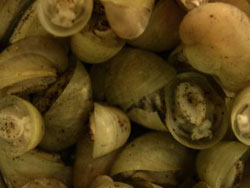Deep sea animals stowaway on submarines and reach new territory

This is a photo of Lepetodrilus gordensis, the species recovered from the Alvin submersible.<br>Credit: Todd Haney<br>
The team's findings, published in Conservation Biology, reveal how a species can be inadvertently carried by submersibles to new areas, with potentially damaging effects on marine ecosystems.
After using the manned submersible Alvin to collect samples of species from the Juan de Fuca Ridge under the northeastern Pacific Ocean, the team discovered 38 deep-sea limpets ( Lepetodrilus gordensis) among their sample. Intriguingly this species is believed to occur only in the vents of the Gorda Ridge, which are 635 km south of the dive site.
“The big question was, how did they get over 600 kilometers from their habitat?” said Dr. Janet Voight, from the Field Museum of Natural History in Chicago. “We discovered that the individuals must have been transported from the Gorda Ridge by our submersible. Even though we clean the submersibles after sampling we had assumed that the extreme pressure change would kill any species which are missed.”
The introduction of new species to an ecosystem by humans, often inadvertently, is a big challenge to conservation. How a new species will react to new surroundings, and the effect it can have, is unpredictable. Increases in deep-sea drilling and submersible activity can increase the probability of introductions, but until now hydrothermal vents have been considered too extreme and too isolated to be a source of introduced species.
In coastal environments one of the biggest threats posed by invasive species to native species is disease, as newly introduced pathogens and parasites can cause mass mortality. Diseases that may exist in the extreme environments created by hydrothermal vents have not been well studied.
“We've discovered that it is possible to accidently introduce a species, and any potential diseases it may carry, from a deep-sea vent to a new location,” concluded Voight. “This has implications for the future exploration of hydrothermal vents as it reveals the potential risk of human driven change to the ecosystem.”
Media Contact
More Information:
http://www.wiley.comAll latest news from the category: Ecology, The Environment and Conservation
This complex theme deals primarily with interactions between organisms and the environmental factors that impact them, but to a greater extent between individual inanimate environmental factors.
innovations-report offers informative reports and articles on topics such as climate protection, landscape conservation, ecological systems, wildlife and nature parks and ecosystem efficiency and balance.
Newest articles

Recovering phosphorus from sewage sludge ash
Chemical and heat treatment of sewage sludge can recover phosphorus in a process that could help address the problem of diminishing supplies of phosphorus ores. Valuable supplies of phosphorus could…

Efficient, sustainable and cost-effective hybrid energy storage system for modern power grids
EU project HyFlow: Over three years of research, the consortium of the EU project HyFlow has successfully developed a highly efficient, sustainable, and cost-effective hybrid energy storage system (HESS) that…

After 25 years, researchers uncover genetic cause of rare neurological disease
Some families call it a trial of faith. Others just call it a curse. The progressive neurological disease known as spinocerebellar ataxia 4 (SCA4) is a rare condition, but its…





















